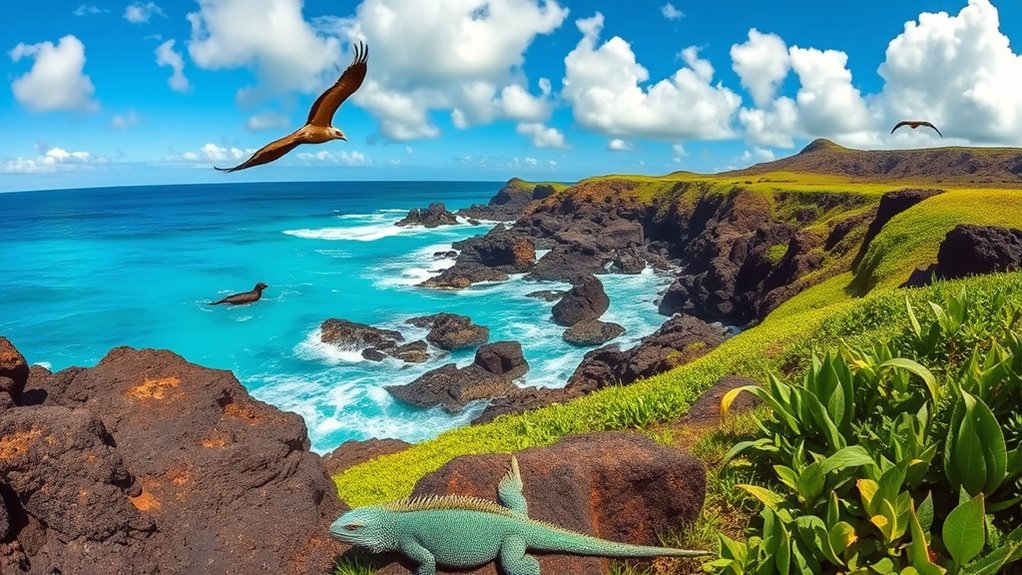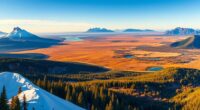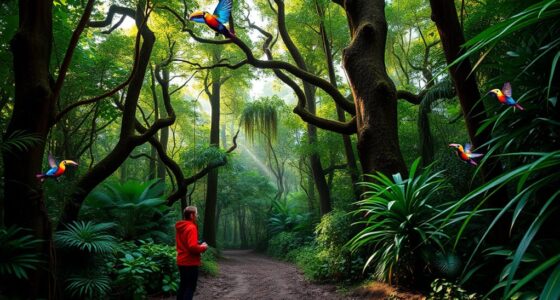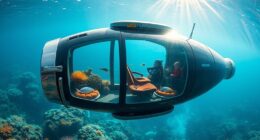Exploring the Galápagos Islands is a naturalist’s dream come true. You’ll find breathtaking landscapes shaped by millions of years of volcanic activity, unique wildlife, and diverse ecosystems. Encounter iconic species like giant tortoises, marine iguanas, and Darwin’s finches — all found nowhere else on Earth. From snorkeling with sea lions to hiking up volcanic trails, there are endless adventures awaiting you. There’s so much more to discover about this remarkable archipelago that awaits your exploration.
Key Takeaways
- The Galápagos Islands are home to unique wildlife, with 80% of land birds and 97% of reptiles endemic to the region.
- Diverse marine life can be explored in the Galápagos Marine Reserve, including sea lions, marine iguanas, and vibrant coral reefs.
- Iconic species like Darwin’s finches and flightless cormorants offer a glimpse into evolutionary history and adaptation.
- Activities such as diving, snorkeling, and hiking provide immersive experiences in the islands’ stunning natural landscapes.
- The archipelago’s rich history, including Charles Darwin’s visit, adds cultural depth to the natural exploration experience.
Geographic Wonders of the Galápagos Islands
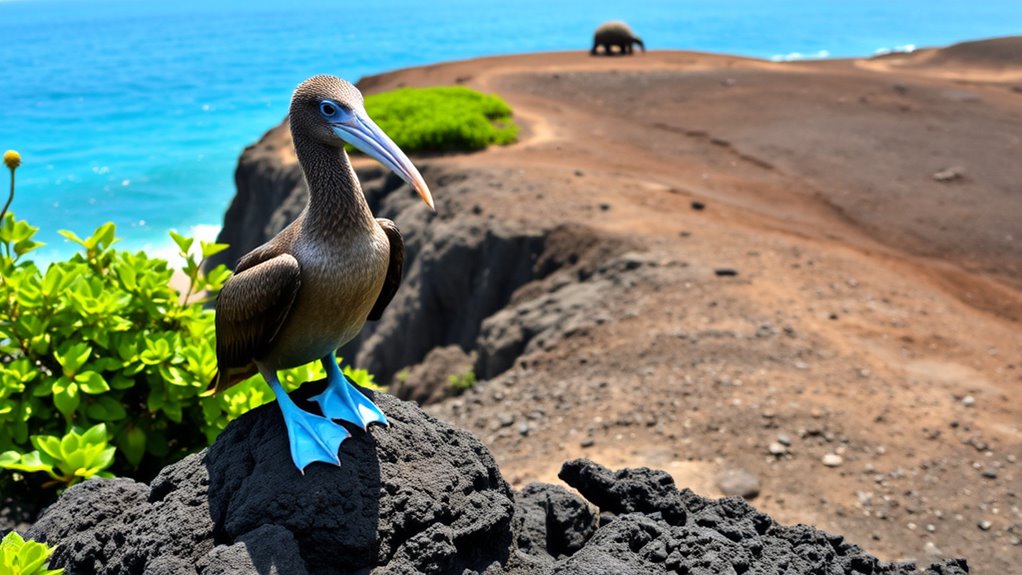
Discovering the geographic wonders of the Galápagos Islands reveals a striking blend of natural beauty and geological activity.
Located in the Eastern Pacific, these islands stretch across about 45,000 km² of ocean and include 127 islands, with Isabela being the largest.
You’ll find rugged mountains, unique rock formations, and active volcanoes like Volcán Wolf, which rises 1,707 meters.
The landscape is shaped by over 20 million years of volcanism, resulting in dramatic lava fields and coastal areas.
Over 20 million years of volcanism have sculpted the Galápagos landscape into stunning lava fields and coastal vistas.
The islands’ varied terrain and ongoing geological activity make them a captivating destination.
As you explore, you’ll appreciate how the land reflects the dynamic forces that continue to mold this extraordinary archipelago, making it a true marvel of nature. Additionally, the unique biodiversity found in the Galapagos adds to the islands’ ecological significance.
The Unique Ecosystem and Biodiversity
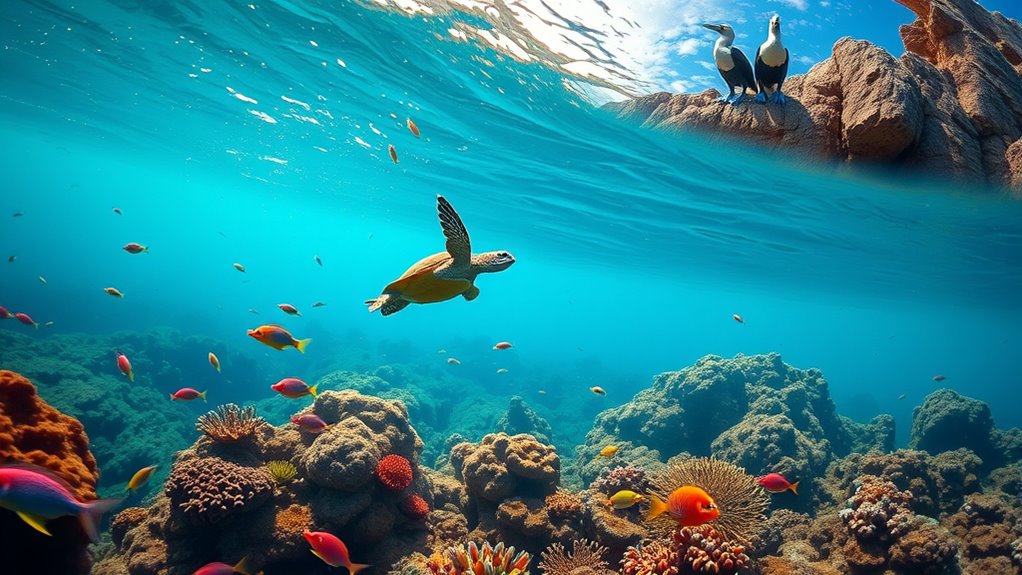
The Galápagos Islands aren’t just known for their stunning landscapes; they also boast an incredible array of ecosystems and biodiversity.
You’ll find both marine and terrestrial habitats here, each supporting unique species found nowhere else on Earth. The Galápagos Marine Reserve is vital for protecting marine life, from vibrant coral reefs to marine iguanas.
On land, endemic giants like the tortoises thrive alongside the Flightless Cormorant. With about 80% of land birds and 97% of reptiles unique to these islands, their biodiversity is unparalleled.
Each ecosystem plays a crucial role, maintaining ecological balance and providing essential services, like tourism and sustainable fishing.
Exploring this rich tapestry of life is a naturalist’s dream that you won’t want to miss.
Iconic Wildlife to Discover
When you explore the Galápagos Islands, you’ll encounter a remarkable range of iconic wildlife that captivates the senses.
The playful Galapagos sea lions bask on the beaches, while the elusive Galapagos fur seals prefer shaded spots, showcasing their large eyes and ears. You’ll appreciate how these mammals exhibit unique behaviors, unafraid of human presence.
Among the birds, Darwin’s finches, with their diverse beak shapes, play a role in evolutionary history, while the flightless cormorant impresses with its underwater hunting prowess.
Don’t miss the Galapagos penguins—small, endangered, and the only penguins north of the equator.
Lastly, marvel at the majestic Galapagos giant tortoises, symbols of the islands, living over a century and weighing up to 417 kg.
The Rich History of the Archipelago
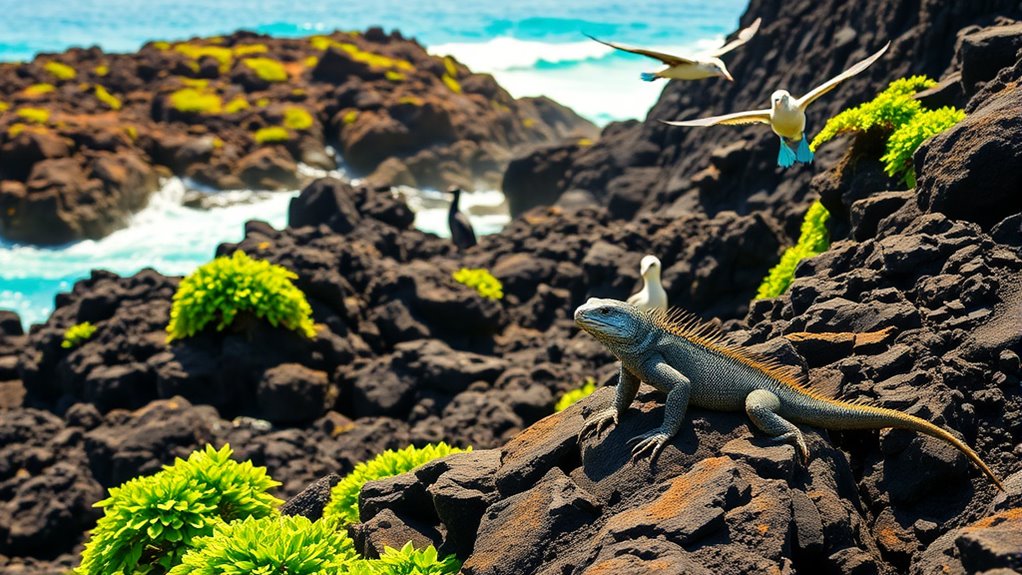
Although many visitors flock to the Galápagos Islands for their breathtaking wildlife, the archipelago’s rich history is equally captivating.
European exploration began in 1535 with Spanish bishop Tomás de Berlanga, followed by English captain Richard Hawkins in 1593. The islands were a pirate haven in the 17th and 18th centuries, exploited for ambushing Spanish treasure fleets.
In 1831, colonization efforts began with the Sociedad Colonizadora del Archipiélago de Galapagos, leading to Ecuador’s annexation in 1832. The first permanent settlement emerged on Floreana Island, named Haven of Peace by José de Villamil.
Charles Darwin’s visit in 1835 aboard the HMS Beagle marked a pivotal moment, as his observations sparked groundbreaking theories in evolution and natural selection.
Activities for Nature Enthusiasts
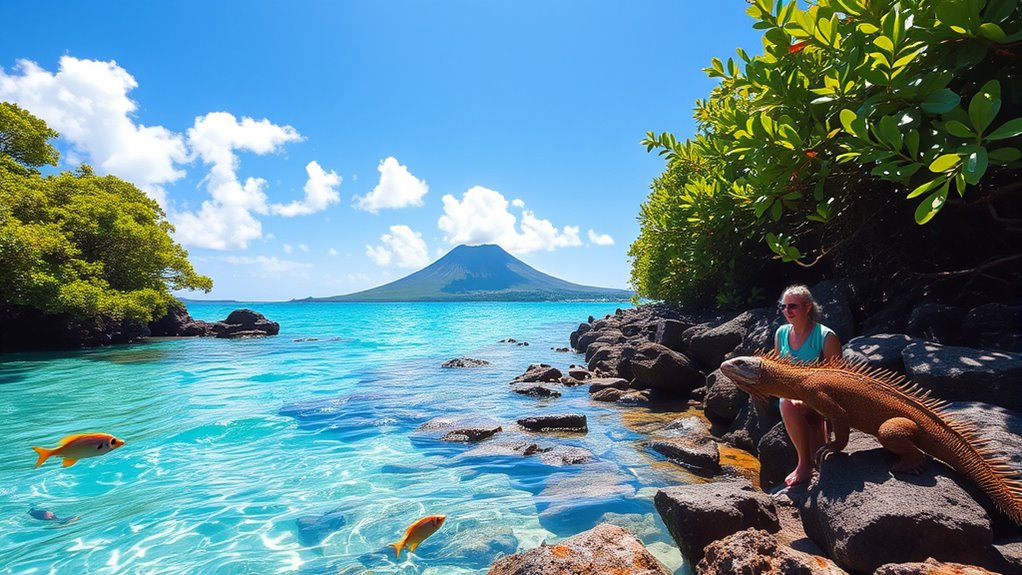
For nature enthusiasts, the Galápagos Islands offer an unparalleled playground filled with diverse activities that allow you to immerse yourself in stunning landscapes and unique wildlife.
Dive into crystal-clear waters, where you can interact with hammerhead sharks and giant manta rays, or snorkel to see sea lions and sea turtles up close.
Sea kayaking provides a unique perspective of the islands’ flora and fauna, while San Cristóbal Island is perfect for surfing.
On land, hike the lava trails of Sierra Negra Volcano, visit pristine beaches like Playa Baquerizo, and explore nature trails that showcase the unique bird species.
Don’t miss the chance to encounter Galápagos giant tortoises and experience the vibrant wildlife that inspired Darwin.
Conservation Efforts and Challenges
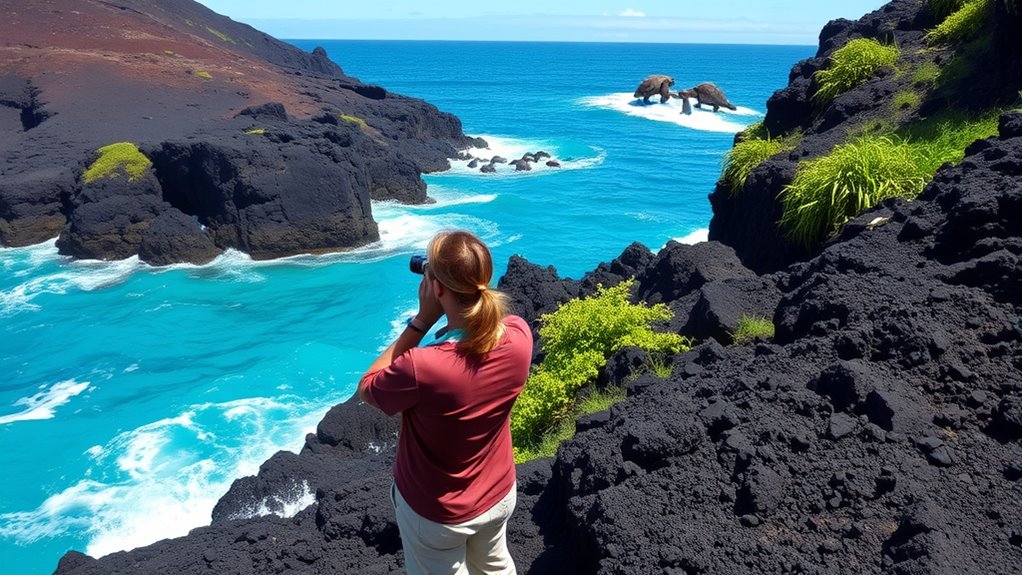
While exploring the breathtaking landscapes and wildlife of the Galápagos Islands, it’s important to recognize the ongoing conservation efforts aimed at preserving this unique ecosystem.
Species protection programs focus on breeding endangered creatures like the Galapagos Giant Tortoise and Penguin. Invasive species eradication targets non-native animals threatening native wildlife, while the Galapagos Marine Reserve promotes sustainable fishing.
Environmental education initiatives help raise awareness among locals and tourists alike. However, challenges like funding shortages, community engagement, and complex governance hinder progress.
You’re encouraged to support these efforts by choosing sustainable options and respecting local regulations during your visit. Together, we can ensure the Galápagos remains a vibrant haven for future generations to explore and enjoy.
Planning Your Visit to the Galápagos
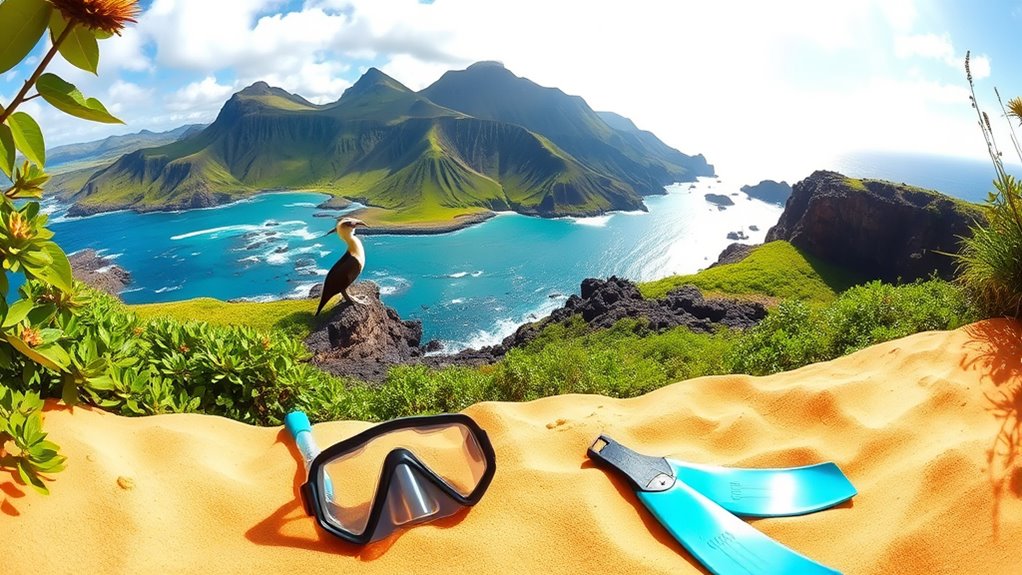
How can you make the most of your visit to the Galápagos Islands? Start by budgeting between $1,000 and $5,000 for your trip.
Ensure your passport is valid, and check if you need a visa upon arrival in Ecuador. Book your flights to the Galápagos with an overnight stay in Quito or Guayaquil.
Don’t forget to get vaccinated against COVID-19 and consider travel insurance, especially if you’re planning a cruise.
Choose between various tour options like cruises, day trips, or independent travel on inhabited islands. Prioritize must-visit spots like Santa Cruz and San Cristobal, and plan for activities like snorkeling and hiking.
Finally, consider visiting during the dry season for the best experience.
Frequently Asked Questions
What Is the Best Time of Year to Visit the Galápagos?
The best time to visit the Galápagos is from December to May, when the weather’s warm and the seas are calm, perfect for snorkeling and diving.
However, if you prefer cooler temperatures and fewer tourists, consider visiting from June to November.
Each season offers unique wildlife experiences, so you can’t go wrong.
If you want the best of both worlds, aim for the shoulder months of May and November for great wildlife encounters.
Are There Any Health Precautions to Consider Before Traveling?
Before you travel, consider several health precautions.
Get vaccinated for Hepatitis A and B, and the Typhoid Fever vaccine, as food and waterborne illnesses can be a risk. Make sure your routine vaccinations are up to date.
Protect yourself from mosquito-borne illnesses like dengue by using DEET repellent, wearing long sleeves, and staying in screened areas.
Staying informed will help ensure a safer and healthier trip.
What Accommodations Are Available on the Islands?
When you step into the Galapagos, it’s like entering a world where nature reigns supreme.
On Santa Cruz Island, you’ll find the most diverse hotel options, particularly in Puerto Ayora and the highlands.
Isabela Island’s hotels cluster in Puerto Villamil, while San Cristobal offers accommodations in Puerto Baquerizo Moreno.
Floreana Island has fewer choices, mainly in Puerto Velasco Ibarra.
Luxury seekers can indulge at places like Pikaia Lodge or Galapagos Magic.
How Can I Minimize My Environmental Impact While Visiting?
To minimize your environmental impact while visiting, start by following park regulations closely.
Stick to designated paths and maintain a safe distance from wildlife. Always use eco-friendly products and avoid single-use plastics.
Support local businesses that prioritize sustainability and conservation. Participate in guided tours to ensure you’re informed about the local ecosystem.
Lastly, consider offsetting your carbon footprint through donations to conservation projects in the area. Every small action counts!
Are There Any Local Customs or Etiquette to Be Aware Of?
When you visit the Galapagos, you’ll find that respecting local customs is crucial.
It’s not just about enjoying the beauty; it’s about preserving it too. Keep a safe distance from wildlife, stick to marked trails, and always pack out your trash.
Don’t smoke in the park, and ensure your shoes are clean before stepping onto the islands.
Conclusion
As you wander through the enchanting landscapes of the Galápagos, with sun-drenched shores and vibrant wildlife surrounding you, the magic of this archipelago captures your heart. Each step reveals a new marvel, from the blue-footed boobies dancing on the rocks to the ancient tortoises grazing in the wild. Embrace the call of adventure, and let the spirit of discovery guide you. The Galápagos isn’t just a destination; it’s a transformative experience waiting to unfold.
